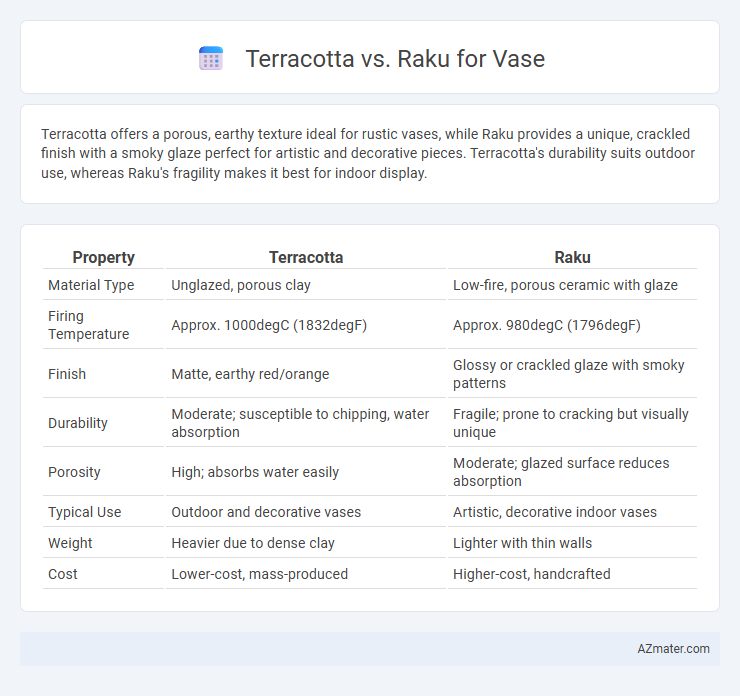Terracotta offers a porous, earthy texture ideal for rustic vases, while Raku provides a unique, crackled finish with a smoky glaze perfect for artistic and decorative pieces. Terracotta's durability suits outdoor use, whereas Raku's fragility makes it best for indoor display.
Table of Comparison
| Property | Terracotta | Raku |
|---|---|---|
| Material Type | Unglazed, porous clay | Low-fire, porous ceramic with glaze |
| Firing Temperature | Approx. 1000degC (1832degF) | Approx. 980degC (1796degF) |
| Finish | Matte, earthy red/orange | Glossy or crackled glaze with smoky patterns |
| Durability | Moderate; susceptible to chipping, water absorption | Fragile; prone to cracking but visually unique |
| Porosity | High; absorbs water easily | Moderate; glazed surface reduces absorption |
| Typical Use | Outdoor and decorative vases | Artistic, decorative indoor vases |
| Weight | Heavier due to dense clay | Lighter with thin walls |
| Cost | Lower-cost, mass-produced | Higher-cost, handcrafted |
Introduction to Terracotta and Raku Vases
Terracotta vases are crafted from porous earthenware clay, offering a rustic appearance and excellent breathability, making them ideal for outdoor and indoor plants. Raku vases, originating from traditional Japanese pottery techniques, undergo rapid firing and cooling processes that create unique, crackled finishes with vibrant glaze effects. Both materials provide distinct aesthetic qualities and functional benefits, catering to diverse artistic and horticultural preferences.
Historical Origins of Terracotta and Raku
Terracotta, originating from ancient civilizations such as Mesopotamia and the Indus Valley over 7,000 years ago, is a porous clay material renowned for its durability and earthy reddish-brown hue, commonly used in sculpting and pottery. Raku pottery, developed in 16th-century Japan, is characterized by its rapid firing and cooling process, resulting in unique crackle patterns and an unpredictable glaze finish that reflects Zen Buddhist aesthetics. While terracotta emphasizes robustness and tradition, Raku is celebrated for its spontaneity and philosophical ties to Japanese tea ceremonies.
Material Composition: Terracotta vs Raku
Terracotta vases are made from natural clay fired at low temperatures, resulting in a porous, earthy material known for its durability and rustic appearance. Raku vases are crafted from a specific type of clay fired rapidly at high temperatures and then cooled quickly, often producing unpredictable glaze effects and a unique crackled texture. The key difference lies in terracotta's uniform, porous composition versus raku's variable, often glazed surface influenced by the post-firing reduction process.
Firing Techniques Compared
Terracotta vases are fired at lower temperatures between 1,000degC and 1,150degC, resulting in a porous, reddish-brown finish suitable for outdoor use but requiring sealing to prevent water absorption. Raku firing involves rapid heating to approximately 980degC followed by immediate cooling in open air or reduction chambers, producing unique crackled patterns and metallic lusters due to thermal shock and smoke interaction. The difference in firing techniques impacts durability, texture, and aesthetics, with terracotta offering robust, earthy tones and raku providing unpredictable, artistic glaze effects.
Surface Finishes and Color Variations
Terracotta vases exhibit earthy, matte surface finishes with natural reddish-brown hues attributed to iron content, providing warm and rustic tones ideal for traditional aesthetics. Raku vases feature unpredictable, crackled surface finishes with metallic sheens and smoky color variations achieved through post-firing reduction processes, yielding unique textures and iridescence. The color palette of Terracotta remains consistent and muted, whereas Raku offers vibrant, dynamic contrasts ideal for artistic and contemporary designs.
Durability and Structural Strength
Terracotta vases offer moderate durability due to their porous nature, requiring sealing to enhance water resistance and prevent cracking over time. Raku vases, while valued for their unique glaze and artistic appeal, tend to be more fragile and less structurally strong because of the rapid cooling process that can introduce brittleness and micro-fractures. For long-term durability and higher structural integrity, terracotta is generally preferred over raku in vase production.
Artistic Styles and Aesthetic Appeal
Terracotta vases showcase a warm, earthy aesthetic with natural reddish-brown hues and a rustic, handcrafted texture often associated with traditional pottery. Raku vases feature unique surface effects created through rapid cooling and post-firing reduction, resulting in unpredictable crackles, metallic sheens, and smoky patterns that highlight individual artistry. The artistic style of terracotta emphasizes organic simplicity and durability, while Raku prioritizes spontaneous, expressive finishes that appeal to collectors seeking distinctive, one-of-a-kind pieces.
Functional Uses in Vase Making
Terracotta vases excel in durability and breathability, making them ideal for outdoor gardening and plant pots that require moisture regulation. Raku vases offer unique aesthetic appeal with their crackled surfaces but are less porous and more fragile, limiting their functional use primarily to decorative indoor settings. Choosing between terracotta and raku depends on the vase's intended use, with terracotta favored for practical planting and raku for artistic display.
Maintenance and Longevity
Terracotta vases require regular sealing to prevent moisture absorption and are prone to chipping over time, impacting durability. Raku-fired vases feature a unique, crackled glaze that enhances aesthetic value but makes them more fragile and sensitive to temperature changes. Maintenance for Raku involves gentle cleaning without harsh chemicals, while terracotta demands more frequent upkeep to maintain structural integrity.
Choosing the Right Technique for Your Vase
Terracotta offers durability and a classic earthy texture ideal for large, functional vases, while Raku provides unique, unpredictable glazes suited for artistic, decorative pieces. Choosing between Terracotta and Raku depends on desired vase usage, with Terracotta favored for stability and outdoor use, and Raku chosen for its vibrant, one-of-a-kind finishes. Understanding these material properties and firing techniques helps artisans create vases that balance aesthetics, strength, and intended environment.

Infographic: Terracotta vs Raku for Vase
 azmater.com
azmater.com